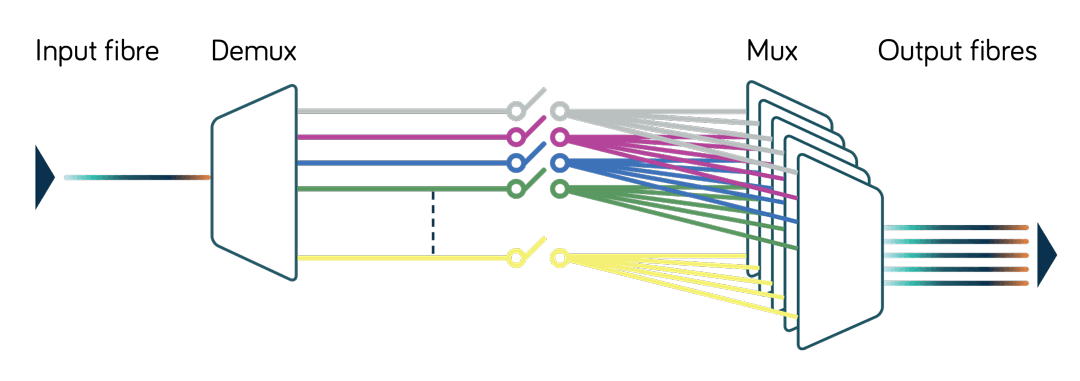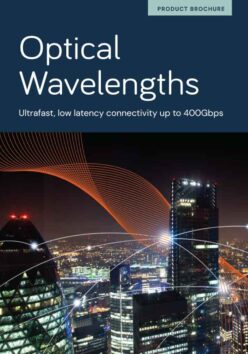Get ultrafast, low latency Optical Wavelengths
What are ROADMs?
A ROADM, or reconfigurable optical add-drop multiplexer, is a device that manages the routing of data signals in fibre optic networks. It enables network operators to remotely provision network traffic without redesigning the network.
The different channels (colours of light) transmitted over fibre networks are called optical wavelengths. The light signal on a single fibre is separated into multiple optical wavelengths using a technology called Wavelength Division Multiplexing. Today, Dense Wavelength Division Multiplexing (DWDM) is typically used for high capacity, long-haul fibre networks as it supports a large number of channels over long distances.
In traditional DWDM systems, wavelength routing is fixed: each wavelength is assigned a path through the network. In DWDM with ROADMs, wavelengths can be added, dropped or rerouted as needed, significantly increasing a network’s flexibility and efficiency.
ROADM components
ROADMs comprise various technologies that manage and route light signals. Here are some of the main components.
Wavelength selective switch
A key element of ROADMs, a wavelength selective switch (WSS) can switch incoming optical signals to different output ports based on their wavelength. This allows you to reconfigure optical paths as needed remotely.
Optical add-drop module
An optical add-drop module (OADM) can add or drop specific wavelengths at various points on the network. Working with a WSS, it manages the routing of individual wavelengths on the network.
Optical amplifier
An optical amplifier boosts the signal of optical wavelengths to compensate for losses during transmission and switching. Amplification is vital to maintain the signal strength over long distances.
Optical channel monitor
An optical channel monitor (OCM) monitors the performance and quality of each optical signal. OCMs enable remote monitoring, detect signal degradation and failures, and help to optimise the network.
How does a ROADM WSS work?
Put simply, a wavelength selective switch performs the following basic functions in a ROADM system:
- The WSS receives multiple optical wavelengths from an input fibre.
- An optical demultiplexer (demux) demultiplexes (separates) the incoming signals into their individual wavelengths.
- The WSS switches specific wavelengths to the output ports determined by the network management system.
- A multiplexer (mux) combines the wavelengths into one signal (if necessary) before sending it through the output port.
After exiting the output ports, the wavelengths may pass through other components, like add-drop modules or amplifiers, to continue along the network.
In a DWDM system without ROADMs, specific wavelengths are separated and routed to fixed output fibres. With ROADMs, the WSS allows wavelengths to be mapped to any output fibre, as shown below.
ROADM WSS basic function

In short, a WSS is a core component of ROADMs, providing flexible switching functionality without the need for manual intervention.
Types of ROADM technology
Since ROADMs first appeared in the early 2000s, various types of ROADM have emerged to provide greater flexibility and efficiency. Here are the main types of ROADM architectures.
Colourless ROADM
A colourless ROADM does not map specific wavelengths (colours) to particular ports. It allows any wavelength to be added or dropped at any port.
Directionless ROADM
The simplest, fixed filter ROADMs only allow wavelengths to be routed in a particular direction. In contrast, a directionless ROADM enables wavelengths to be added or dropped in any direction.
Contentionless ROADM
Traditionally, ROADMs have suffered from contention – interference that arises when multiple optical signals compete for the same wavelength on a fibre path. With a contentionless ROADM, multiple instances of the same wavelength can be added or dropped without interference, boosting flexibility and efficiency.
CDC ROADM
Combining all the capabilities above, a colourless, directionless, contentionless (CDC) ROADM provides the greatest routing flexibility. A CDC ROADM can switch any wavelength in any direction without suffering from contention.
In addition, today’s ROADMs also feature flexible wavelengths. Earlier, ROADMs followed a specific channel plan as defined by the ITU. Today, most ROADMs support a flexible grid, allowing different channel widths and spacing between channels.
For example, at Neos Networks we currently use a mix of fixed and flexible grid ROADMs in a DWDM network capable of up to 800Gbps wavelengths.
ROADMs and DWDM
ROADMs and DWDM are both vital technologies in high capacity optical fibre networks. While DWDM boosts the capacity of optical networks by allowing multiple wavelengths on a single fibre, ROADMs significantly increase the flexibility of DWDM-enabled networks.
By using ROADMs in DWDM systems, network operators can:
- Add or drop specific optical wavelengths at various points in the network without disrupting network traffic
- Dynamically reconfigure the routing of optical signals without rewiring or changing physical connections as demand requires
- Implement ‘multi-degree networking’, in other words, connect several fibre paths per node to create ring or mesh networks
The flexibility provided by ROADMs can help you future-proof your network. You can easily scale capacity up or down and reroute traffic as demand changes without costly infrastructure changes.
In addition, multi-degree implementations of ROADMs can significantly enhance network efficiency and resilience: if one fibre path goes down, you can simply reroute traffic.
Overall, by implementing DWDM with ROADMs you can significantly boost your optical network's efficiency, flexibility, scalability and resilience.
ROADMs for your network
At Neos Networks, we specialise in using ROADMs and DWDM to deliver high capacity, low latency networks across the UK. We’re helping businesses nationwide transform their networks with Optical Wavelengths providing speeds up to 400Gbps.
If you’re looking to upgrade your network to meet the exploding demand for bandwidth, get in touch. We’ll be happy to make connectivity work for your business.
Get ultrafast, low latency Optical Wavelengths
ROADM FAQs
-
What are optical wavelengths?
Optical wavelengths refer to the light channels that transmit data in fibre optic networks. The light signal is divided into multiple channels with different frequencies and wavelengths, each transmitting a different data stream.
-
What is Wavelength Division Multiplexing (WDM)?
Wavelength Division Multiplexing (WDM) is a technology that can expand the capacity of optical fibre by adding a multiplexer and a demultiplexer at each end. This enables different data streams to be sent over a single optical fibre simultaneously.
-
What are the benefits of using ROADMs with Wavelength Division Multiplexing?
Using ROADMs with WDM allows you to dynamically add, drop or reroute optical wavelengths without physically reconfiguring the network. This significantly boosts the network’s scalability and efficiency while enhancing resilience through network diversity.
-
Where are ROADMs typically used?
ROADMs are typically used in high capacity long-haul and metro optical networks, backbone networks, data centre interconnects and large enterprise networks. They provide reliable, flexible, and scalable management of optical wavelengths in various networking scenarios.
-
What is the difference between coloured and colourless ROADMs?
Coloured ROADMs have fixed ports allocated to a particular wavelength channel. In contrast, colourless ROADMs allow any wavelength to be added or dropped at any port, providing greater flexibility and efficiency.
-
How do ROADMs make networks more scalable?
ROADMs make networks more scalable by enabling you to remotely add or drop optical wavelengths as demand changes without redesigning the network. In addition, ROADMs optimise the use of existing fibre infrastructure, allowing multiple data streams to be efficiently routed over the same optical network.







